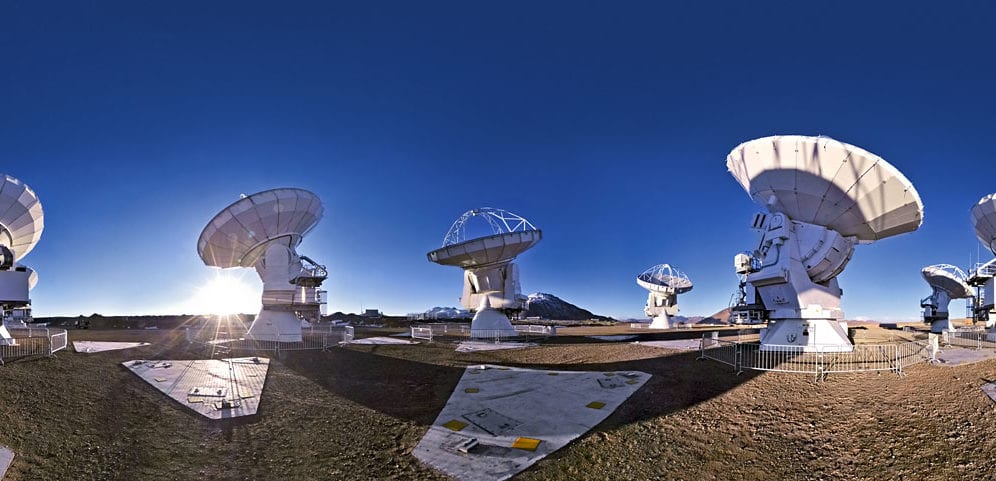By: Paula Leighton
Send to a friend
The details you provide on this page will not be used to send unsolicited email, and will not be sold to a 3rd party. See privacy policy.
[SANTIAGO] Despite having the world’s best skies for stargazing and numerous subsidies for setting up international observatories, Chile is not benefitting enough from astronomy, say local astronomers and engineers.
By the mid-2020s Chile will be home to about 70 per cent of the world’s telescopes, with investments in excess of US$4 billion in its four largest telescopes.
These are the Atacama Large Millimeter Array (ALMA), inaugurated in 2013; the European Extremely Large Telescope (E-ELT), which will start operating in 2023; the Giant Magellan Telescope, due to start operation in 2020; and the Large Synoptic Survey Telescope, operating from 2019.
With an average of 330 clear nights a year, a dry climate and several mountains over 3,000 meters high, the Atacama Desert is deemed the best place in the world for building optical and radio telescopes.
Researchers say Chile should be capitalising better on this natural advantage. For example, the government could require organisations behind telescopes to set aside more observation time for Chilean astronomers. And it could be channeling tax revenues from the big astronomy projects into education and scientific development initiatives.
Currently, the contract conditions Chile offers to foreign astronomy research consortia are generous, according to Mónica Rubio, an astronomer at the University of Chile and former director of the Astronomy Programme at the National Commission for Scientific and Technological Research (CONICYT).
Since 1964 Chile has exempted telescope construction consortia from customs duties. It also refunds the 19 per cent VAT on costs associated with construction materials, tools and services for operating and maintaining the telescopes.
In addition the government offers diplomatic status to foreign staff doing astronomical research in Chile, which prevents authorities from overseeing workers’ contracts, according to claims by ALMA workers during a strike last year.
In exchange for these benefits consortia pay the state an annual fee to cover the cost of renting the land telescopes are built on, astronomy postgraduate studentships at Chilean universities, and funds to benefit the local communities where the telescopes are located, such as scholarships and educational projects.
Observatories must also set aside 10 per cent of their observation time for Chilean institutions. Yet “the figure is lower than other astronomy hot spots such as Hawaii, which usually gets 15 per cent, and the Canary Islands, where 20 per cent of observation time for Spanish institutions is required, and also hiring must include five per cent of Spanish engineers and staff,” Rubio tells SciDev.Net.
Despite all this, Chile’s high frequency of clear nights and its generous tax exemptions make it more desirable for astronomy than rivals the Canary Islands or Hawaii, according to a study commissioned by CONICYT in 2011.
“Chile should include in its agreements that our universities and engineers take part in the development and manufacturing of astronomy instruments, which observatories must upgrade regularly.”
Mónica Rubio, University of Chile
The study calculated the hypothetical cost of building and maintaining the Europe-owned E-ELT telescope in different countries. In Chile the figure came to about US$500,000 per night, whereas in Hawaii it was US$725,000 and in Spain it was US$830,000.
Maximiliano Moyano, an astronomer at the Catholic University of the North, says the 10 per cent of observation time set aside for Chilean astronomers is increasingly insufficient to meet demand.
“Many astronomers doing doctorates abroad are due to come back,” he says, which would increase demand further. Many scientists in Chile collaborate with foreign universities, which then benefit by receiving some of the Chilean allocation.
But not all astronomers question the 10 per cent figure. Rubio says that because Chile's astronomy community is relatively small, the allocation is shared between fewer astronomers, so is more generous than in Europe or the United States.
“It is clear that the 10 per cent has been the most important factor to boost development of astronomy in Chile,” Wolfgang Gieren, astronomy professor at the University of Concepción, tells SciDev.Net.
Now Chilean academics are trying to persuade ministers to make legislative changes that will foster local expertise in telescope construction and maintenance, says Rubio.
“Chile should include in its agreements that our universities and engineers take part in the development and manufacturing of astronomy instruments, which observatories must upgrade regularly,” says Rubio.
Gieren says this kind of training “would foster the development of high-tech private companies in Chile”.
And training Chileans in the use of big data harvested by telescopes could also benefit other areas of society, says Rubio.
In addition, the 19 per cent VAT that telescope manufacturers currently have refunded “could be reinvested in astronomy, education or infrastructure,” she says. With operations at each observatory worth between US$5 million and US$80 million each year, that would benefit the country greatly, she says.














